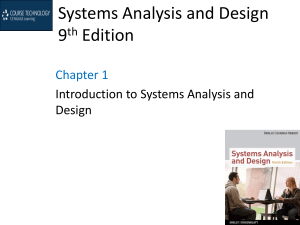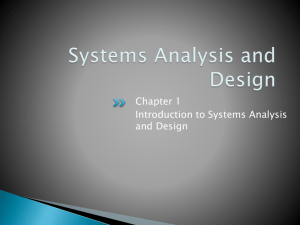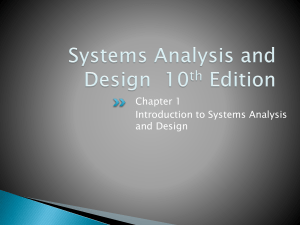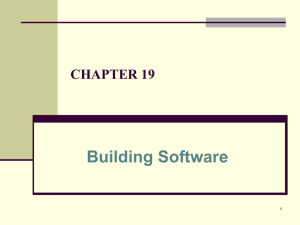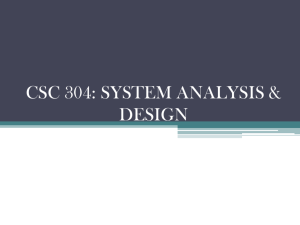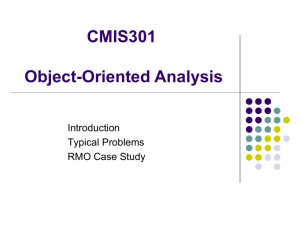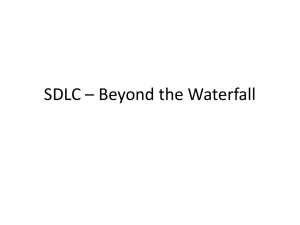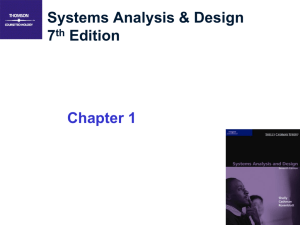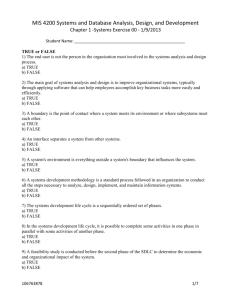Systems Analysis and Design: Chapter 1 Introduction
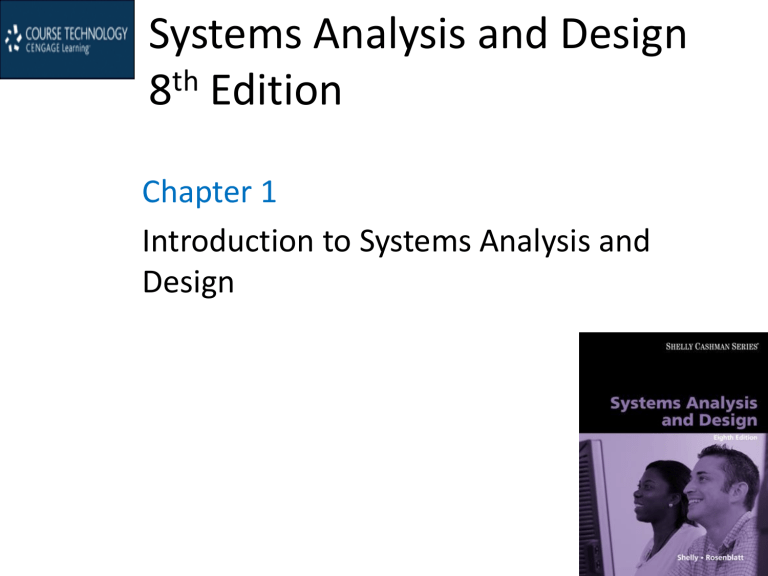
Systems Analysis and Design
8
th
Edition
Chapter 1
Introduction to Systems Analysis and
Design
Chapter Objectives
• Discuss the impact of information technology on business strategy and success
• Define an information system and describe its components
• Explain how profiles and models can represent business functions and operations
• Explain how the Internet has affected business strategies and relationships
2
Chapter Objectives
• Identify various types of information systems and explain who uses them
• Distinguish between structured analysis, object-oriented analysis, and agile methods
• Compare the traditional waterfall model with agile methods and models
• Discuss the role of the information technology department and the systems analysts who work there
3
Introduction
• Companies use information as a weapon in the battle to increase productivity, deliver quality products and services, maintain customer loyalty, and make sound decisions.
• Information technology can mean the difference between success and failure
4
The Impact of Information Technology
• Information Technology (IT)
– Combination of hardware and software products and services that companies use to manage, access, communicate, and share information
• The Future of IT
– Will see robust growth for at least a decade
– The greatest need will be for systems analysts, network administrators, data communications analysts, and software engineers
5
The Impact of Information Technology
• The Role of Systems Analysis and Design
– Systems Analysis and Design
• Step-by-step process for developing high-quality information systems
– Systems Analyst
• Plan, develop, and maintain information systems
6
The Impact of Information Technology
• Who develops Information Systems?
– In-house applications
– Software packages
– Internet-based application services
– Outsourcing
– Custom solutions
– Enterprise-wide software strategies
– How versus What
7
Information System Components
• A system is a set of related components that produces specific results
• A Mission-critical system is one that is vital to a company’s operations
• Data consists of basic facts that are the system’s raw material
• Information is data that has been transformed into output that is valuable to users
• Information systems have five key components: hardware, software, data, processes, and people
8
Information System Components
• Hardware
– Is the physical layer of the information system
– Moore’s Law
• Software
– System software
– Application software
– Enterprise applications
9
Information System Components
• Software
– Horizontal system
– Vertical system
– Legacy systems
• Data
– Tables store data
– By linking the tables, the system can extract specific information
10
Information System Components
• Processes
– Describe the tasks and business functions that users, managers, and IT staff members perform to achieve specific results
• People
– Stakeholders
– Users, or end users
11
Understanding The Business
• Business Process Modeling
• Business Profile
• Business Models
– Business model
– Business process
– Business process reengineering (BPR)
12
Understanding The Business
• New Kinds of
Companies
– Production-oriented
– Service-oriented
– Internet-dependent
– Dot-com (.com)
– Brick-and-mortar
13
Impact of the Internet
• E-Commerce or I-Commerce
• B2C (Business-to-Consumer)
• B2B (Business-to-Business)
– EDI
– Extensible markup language (XML)
– Supplier relationship management (SRM)
14
Impact of the Internet
• Web-Based System
Development
– WebSphere
– .NET
– Web services
– Internet-based systems involve various hardware and software designs
15
How Business Uses Information
Systems
• In the past, IT managers divided systems into categories based on the user group the system served
– Office systems
– Operational systems
– Decision support systems
– Executive information systems
16
How Business Uses Information
Systems
• Enterprise computing systems
– Support company-wide operations and data management requirements
– Enterprise resource planning (ERP)
– Many hardware and software vendors target the enterprise computing market
17
How Business Uses Information
Systems
• Transaction processing systems
– Involve large amounts of data and are missioncritical systems
– Efficient because they process a set of transaction-related commands as a group rather than individually
18
How Business Uses Information
Systems
• Business support systems
– Provide job-related information to users at all levels of a company
– Management information systems (MIS)
– Radio frequency identification (RFID)
– What-if
19
How Business Uses Information
Systems
• Knowledge management systems
– Called expert systems
– Simulate human reasoning by combining a knowledge base and inference rules
– Many knowledge management systems use a technique called fuzzy logic
20
How Business Uses Information
Systems
• User productivity systems
– Technology that improves productivity
– Groupware
• Information systems integration
– Most large companies require systems that combine transaction processing, business support, knowledge management, and user productivity features
21
Information System Users and Their
Needs
22
Systems Development Tools
• Modeling
– Business model
– Requirements model
– Data model
– Object model
– Network model
– Process model
23
Systems Development Tools
• Prototyping
– Prototype
– Speeds up the development process significantly
– Important decisions might be made too early, before business or IT issues are thoroughly understood
– Can be an extremely valuable tool
24
Systems Development Tools
• Computer-Aided Systems Engineering (CASE)
Tools
– Also called computer-aided software engineering
– CASE tools
– Can generate program code, which speeds the implementation process
25
Overview of Systems Development
Methods
• Structured Analysis
– Systems development life cycle (SDLC)
– Predictive approach
– Uses a set of process models to describe a system graphically
– Process-centered technique
– Waterfall model
26
Overview of Systems Development
Methods
• Structured Analysis
– Deliverable or end product
– Disadvantage in the built-in structure of the SDLC, because the waterfall model does not emphasize interactivity among the phases
– This criticism can be valid if the SDLC phases are followed too rigidly
– Adjacent phases usually interact
27
Overview of Systems Development
Methods
• Structured Analysis
– The SDLC model usually includes five steps
• Systems planning
• Systems analysis
• Systems design
• Systems implementation
• Systems support and security
28
Overview of Systems Development
Methods
• Structured Analysis
– Systems Planning
• Systems planning phase
• Systems request – begins the process & describes problems or desired changes
• Purpose of this phase is to perform a preliminary investigation
• Key part of preliminary investigation is a feasibility study
29
Overview of Systems Development
Methods
• Structured Analysis
– Systems Analysis
• Deliverable is the System requirements document
– Systems Design
• Deliverable is system design specification
• Management and user involvement is critical
30
Overview of Systems Development
Methods
• Structured Analysis
– Systems Implementation
• New system is constructed
– Systems Support and Security
• A well-designed system must be secure, reliable, maintainable, and scalable
• Most information systems need to be updated significantly or replaced after several years of operation
31
Overview of Systems Development
Methods
• Object-oriented
Analysis
– Combines data & processes that act on the data into things called objects
– Object is a member of a class
– Objects possess properties
– Methods change an object’s properties
32
Overview of Systems Development
Methods
• Object-Oriented Analysis
– A message requests specific behavior or information from another object
– Usually follow a series of analysis and design phases that are similar to the SDLC
– Interactive model
33
Overview of Systems Development
Methods
• Agile Methods
– Are the newest development
– Emphasizes continuous feedback
– Iterative development
– Agile community has published the Agile
Manifesto
– Spiral model
34
Overview of Systems Development
Methods
• Agile Methods
– Agile process determines the end result
– Other adaptive variations and related methods exist
– Two examples are Scrum and Extreme
Programming (XP)
– Analysts should understand the pros and cons of any approach before selecting a development method
35
Overview of Systems Development
Methods
• Other Development Methods
– Joint application development (JAD)
– Rapid application development (RAD)
– Might encounter other systems development techniques
– Rational Unified Process (RUP®)
– Microsoft Solutions Framework (MSF)
36
Systems Development Guidelines
• Develop a project plan
• Involve users and listen carefully to them
• Use project management tools to identify tasks and milestones
• Develop accurate cost and benefit information
• Remain flexible
37
Information Technology Department
38
The Systems Analyst Position
• Responsibilities
– Translate business requirements into IT projects
• Required Skills and Background
– Solid technical knowledge, strong oral and written communication skills and analytic ability, and an understanding of business operations and processes
• Certification
– Important credential
39
The Systems Analyst Position
• Career Opportunities
– Job titles
– Company organization
– Company size
– Corporate culture
– Salary, location, and future growth
40
Chapter Summary
• IT refers to the combination of hardware and software resources that companies use to manage, access, communicate, and share information
• The essential components of an information system are hardware, software, data, processes, and people
• Most companies offer a mix of products, technical and financial services, consulting, and customer support
41
Chapter Summary
• Systems analyst use modeling, prototyping, and computer aided systems engineering (CASE) tools
• Three popular system development approaches are structured analysis, object-oriented analysis
(O-O), and agile methods, also called adaptive methods
• Regardless of the development strategy, people, tasks, timetables, and cost must be managed effectively using project management tools
42
Chapter Summary
• The IT department develops, maintains and operates a company’s information systems
• Systems analysts need a combination of technical and business knowledge, analytical ability, and communication skills
• Systems analysts need to consider salary, location, and future growth potential when making a career decision
43
Chapter Summary
• Chapter 1 complete
44
